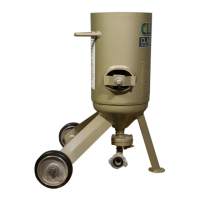MODELS 1028 & 1042 BLAST MACHINES Page 7
© 2013 CLEMCO INDUSTRIES CORP. www.clemcoindustries.com Manual No. 04124, Rev. K
WARNING
OSHA requires remote controls on all blast
machines when an operator controls the nozzle.
Do not tie down the control handle or attempt to
bypass any part of the remote control system.
Doing so will defeat the purpose of the fail-to-
safe feature of the remote control. Severe injury
or death can result from uncontrolled blasting.
3.4.7 If the abrasive metering valve is closed as
instructed, in Section 3.2.6, only air will exit the nozzle.
Adjust the metering valve per Section 3.5.
3.4.8 To stop blasting, release the control handle
lever. The safety lever lock automatically pops up to
prevent accidental activation of the blast machine.
3.4.9 Open the safety petcock. Always open the
safety petcock during work breaks to prevent
unintentional blasting.
3.5 Adjust Abrasive Metering Valve
3.5.1 Abrasive flow is adjusted with the metering
handle. Begin adjustments with the metering valve
closed. Closed is when the handle is turned fully
clockwise when viewed from the top.
3.5.2 Increase abrasive flow by moving the handle
counterclockwise, at 1/8" or increments or less, allowing
time for the flow to stabilize before readjusting.
3.5.3 Optimum abrasive flow depends on the type and
size of abrasive and blast pressure, and can best be
determined by experience. Use as little abrasive as
possible while maintaining the maximum cleaning rate.
The air/abrasive mixture should be mainly air. The
abrasive exiting the nozzle should barely discolor the air
when seen against a contrasting background.
3.6 Loading Abrasive into the Blast Machine
3.6.1 Depressurize the machine using procedures for
manual blasting per Section 3.3, or blasting with remote
controls per Section 3.4.
3.6.2 Load abrasive into the machine by pouring it into
the concave head. Using an optional screen, placed
over the head, prevents large objects from falling inside.
A screen is recommended to keep objects such as
pieces of abrasive bags and rocks from falling into the
machine. Foreign objects will jam the machine. Abrasive
flows through the filling port into the machine. Keep the
abrasive level below the pop-up valve to prevent
abrasive on the pop-up valve from being forced up and
out of the top of the machine when the machine is
pressurized.
3.6.3 After the machine is filled, use procedures for
manual blasting per Section 3.3, or blasting with remote
controls per Section 3.4, to begin blasting.
3.7 Emptying the Machine of Abrasive
3.7.1 When working in environments subject to
extreme temperature changes, or very humid conditions,
condensation may develop inside the machine.
Condensation wets abrasive and causes flow problems.
To prevent this, empty the machine of all abrasive when
shutting down for the day. This will eliminate trouble from
moist abrasive when starting a new day's blasting. One
way to avoid having to empty the machine is to load only
as much abrasive as will be used during the work period.
If the machine must be purged of abrasive, do the
following:
3.7.2 With the blast machine off, turn the blast
pressure to approximately 40-50 psi, close the choke
valve, and set the abrasive metering valve at full open.
3.7.3 Purging the machine without a nozzle, will
eventually erode the thread area of the nozzle holder,
which could cause a hazardous condition. To prevent
wear of the nozzle holder threads, the nozzle should be
firmly attached to the nozzle holder. Removal of the
nozzle is not recommended. If circumstances require the
nozzle to be removed, also remove the nozzle washer.
WARNING
The threads on the nozzle and nozzle holder
must be inspected each time the nozzle is
secured to the holder. A loose fitting nozzle
may eject under pressure and could cause
severe injury. Check the threads for wear, and
make sure the nozzle holder securely holds the
nozzle. The nozzle washer must also be
inspected for wear. When nozzle washers are
worn, abrasive could erode nozzle threads.
3.7.4 Point the nozzle (or hose end) into a drum or
suitable container, or in the direction of the abrasive
disposal location.
3.7.5 Ensure that the hose is secure, and pressurize
the machine.
3.7.6 Depressurize the machine when empty, and
open the choke valve.

